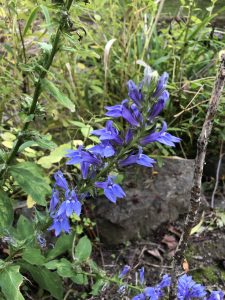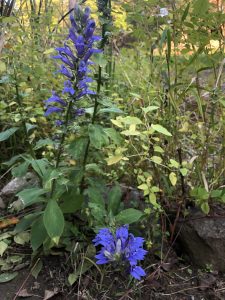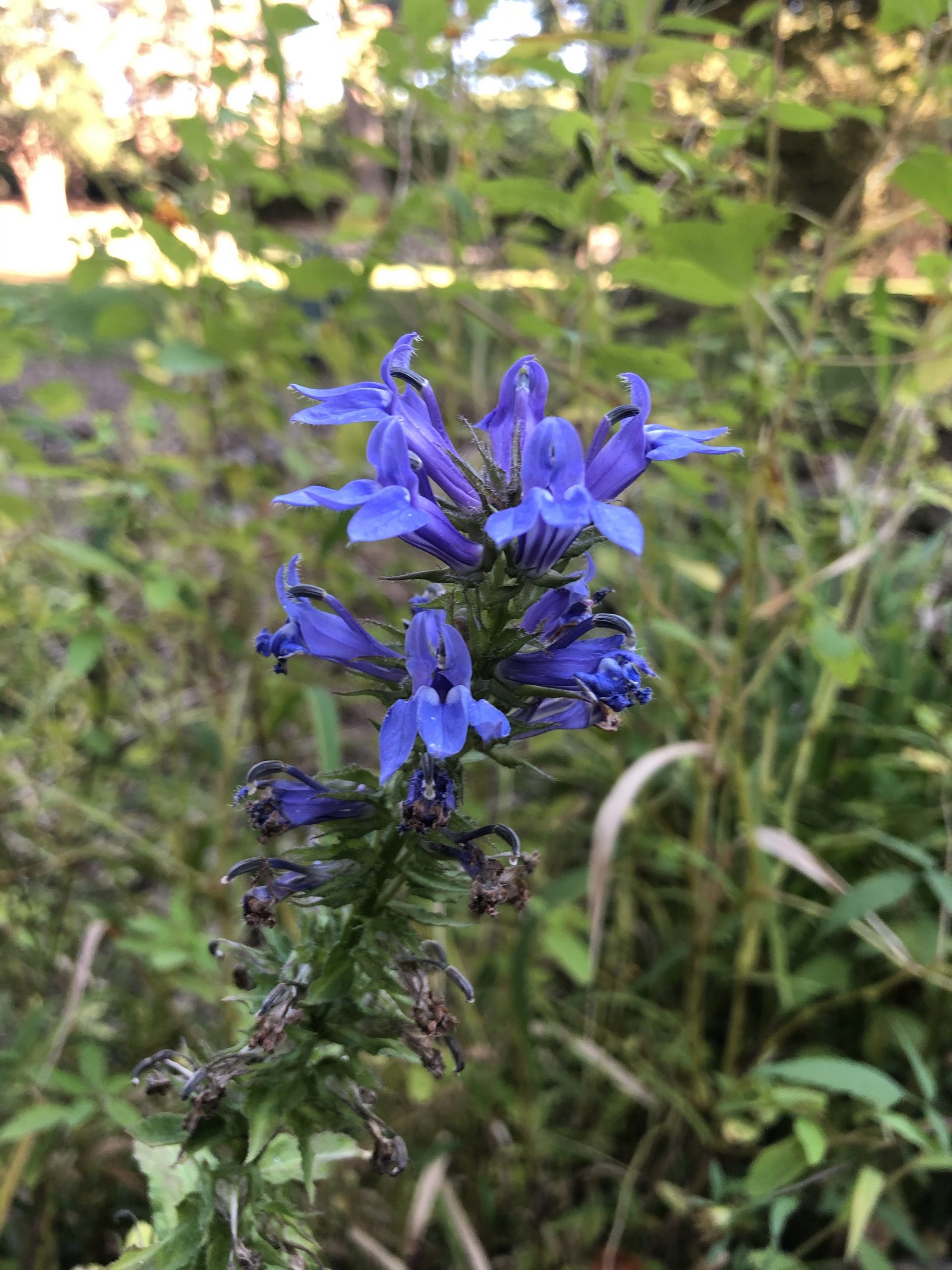I arrived at my sit spot at 5:20pm on October 6th. It was a lot less humid when I went to my sit spot, so the temperature was probably between 70-75°F. It was pretty sunny too for how late it was. However, it felt like the canopy above me was sheltering me from more light than usual.
I walked around my sit spot a little bit to decide what organism I wanted to identify. There aren’t normally a ton of animals in Beale Garden so I knew right away I was going to have to pick some kind of  plant; of which the garden has an abundance of. I was drawn to a couple groups of purple wildflowers close to the creek bed, just to the left of my normal line of view from my sit spot. I identified the group of flowers as Lobelia siphilitica, or Great blue lobelia.
plant; of which the garden has an abundance of. I was drawn to a couple groups of purple wildflowers close to the creek bed, just to the left of my normal line of view from my sit spot. I identified the group of flowers as Lobelia siphilitica, or Great blue lobelia.
I picked the Great blue lobelias (GBL) because purple is one of my favorite colors, so I thought it was really pretty. But also, because it was one of the only flowers in bloom in the garden which I thought was a bit odd. Once I identified it, I found out that the GBL tends to bloom in the late summer and fall. To identify it, I wrote down as much as I could about what the flower looked like. It was about 2-3 feet in height with elongate clusters of flowers and a fuzzy-like stem. It looked like the flower was past its’ blooming peak as it seemed to have brown buds of flowers closer to the base of the stem. Although the buds were grouped together, each flower was about one inch in length.
I tried to use a couple different websites but wasn’t totally convinced I had found a match until I used the app PictureThis that uses pictures of flowers, plants, and other  organisms to identify them. Once I uploaded a quick photo of the purple flower, I received an instant match. After looking through the other photos on the app of the same species, I was convinced that I had found a grouping of Great blue lobelias. I really enjoyed using the app and trying to identify the flower in general, and I think I’ll probably keep it on my phone to identify other types of organisms on a whim.
organisms to identify them. Once I uploaded a quick photo of the purple flower, I received an instant match. After looking through the other photos on the app of the same species, I was convinced that I had found a grouping of Great blue lobelias. I really enjoyed using the app and trying to identify the flower in general, and I think I’ll probably keep it on my phone to identify other types of organisms on a whim.
The name siphilitica comes from the previous medicinal use of the plant. It used to be believed that GBL could cure syphilis and venereal diseases. Although it was later proved that this was not the case, it still had other uses. It was believed by some Native American tribes that if you finely ground up the roots and secretly added it to the food of an arguing couple, they would reconcile and love each other again.

GBL is a popular plant in gardens because of its resistance to wildlife, such as deer. It is considered to be poisonous, however, if ingested, it would not kill you, but it will cause discomfort.
I thought this was a fun twist on our normal assignment, and I really enjoyed getting to sit and look at pretty flowers for 30 minutes! I thought it was going to be hard to spend the whole-time writing observations, but the longer I looked, the more I saw and recorded.


Hey Megan, you did an incredible job! I chose to read your blog because it was about some type of species of purple flower; I also did my species summary on a different species of purple flower, called “Ironweed”. My flower, coincidentally, shares some traits with the species you identified, including the bloom time and the clustered flower growth. I think its really cool that this flower was originally considered a medicinal plant and a curative for different diseases, but its more interesting that it was also used for emotional ailments (such as the need for reconciliation).
Hi Megan! I loved reading about your discovery of the Great blue lobelia at your sit spot. I think that you provided lots of great, specific, and thoughtful descriptions of the plant you identified. I would love to hear more information about the species of plants the Great blue lobelia comes from and its impact on it’s environment, including its role and adaptations. I think you did a wonderful job portraying elements of the plant and the history of the plant. It was a great touch of adding several pictures of the plant from different angles, as well as the analysis of what you thought about the plant. It was fascinating to find out the background and history of the plant. Overall, I think you did a great job describing and analyzing aspects of the plants from an observant lens in order to further describe the plant and its features.
Hi Megan! Great job picking a flower. I’m glad you enjoyed your observation time. I’m actually a little bit envious that you found such a pretty flower, haha! I couldn’t find any around my sit spot. Anyway, I really liked the mini history lesson about the flowers – I wish it actually could be used to cure syphilis or reignite feelings of love; that’d be pretty cool.
I also used PictureThis to identify my plant. I’m glad there’s a simple app out there to use for that haha. I’m curious, did the flower smell like anything?
This flower is so pretty! Your description of the plant was so clear and specific. I also really enjoyed learning about the history of the flower, that was really interesting! I didn’t know about that app, it looks really neat and simple, I’ll have to try it out!